Abstract
New composite adsorbents are proposed to further improve the application of thermochemical energy storage technology in buildings. A volcanic is taken as an adsorption substance, which is impregnated in 36.50 wt% and 54.00 wt% saturated MgCl2 and CaCl2 solutions to prepare composite adsorbents, which are called composite-MgCl2 and composite-CaCl2, respectively. According to the characterization, the main pore structure of the original volcanic is macropores (>100 nm), and hydrated salts tend to fill them. Compared with zeolite-MgCl2, the final water uptake of composite-MgCl2 and composite-CaCl2 increased by 0.15 g/g and 0.03 g/g. Meanwhile, the TG-DSC measurement results show that the thermochemical energy storage densities of composite-MgCl2 and composite-CaCl2 are 1.02 and 1.56 times that of zeolite-MgCl2, which are 642 kJ/kg and 983 kJ/kg, respectively. Moreover, the composition of the thermochemical energy storage densities of the composites is obtained by theoretical calculations, and the theoretically calculated results are close to the measured results. After several cycles, the composites still have high thermochemical energy storage capacity and low energy storage density cost.
1. Introduction
The International Energy Agency (IEA) indicates that buildings account for 40% of energy consumption and 24% of total CO2 emissions [1]. With the requirements of energy saving and zero CO2 emission, renewable energy has attracted the attention of governments and scholars. Solar energy is seen as a promising renewable energy for building heating and is considered an alternative to conventional energy [2]. However, solar energy has periodic fluctuations and is seriously affected by seasons and weather, which induces challenges to its application. Therefore, developing thermal energy storage (TES) technology to store solar energy and supply heat according to demand is an effective solution [3]. TES mainly includes sensible heat, latent heat and thermochemical energy storage [4]. Among them, reversible thermochemical energy storage (TCES) is regarded as a promising technology [5], and the heat loss in the energy storage process is very small [6].
The application of thermochemical energy storage technology in building heating is an effective solution to improve renewable energy utilization efficiency [7]. Hydrated salt composite materials based on porous substrates are very suitable for building heating in the temperature range of 70–180 °C in TCES [8]. The hydrated salt energy storage systems have the advantages of simple operation, high energy storage density and stable circularity. The storage and release of thermal energy can be realized by the desorption and adsorption of water vapor [9,10]. During the energy storage process, the crystal water inside the hydrated salt composite is removed by heating, and the energy is stored in the form of chemical energy. In the energy release process, the water molecules in the humid air combine with the hydrated salt inside the composite, and the chemical energy transforms into heat.
The application of hydrated salt composite materials in buildings requires materials with good thermal characteristics, low cost and great stability. Many scholars have investigated silica gel [11,12], zeolite [13,14], vermiculite [15,16], expanded graphite [17] and other matrices [18,19], while CaCl2 [20], MgCl2 [21,22], LiCl [23,24], and SrCl2 [25] have been studied [26,27]. Some hydrated salt composites are summarized in Table 1, and their reaction temperature (TS, °C), energy storage density (Ed, kJ/kg), cost (CM, yuan/kg) and energy storage density cost (CM/Ed, yuan/kJ) are listed for comparison. Although conventional silica gel and zeolite are cheap, they have low energy storage densities. Expanded graphite has great performance, but it is expensive. Meanwhile, LiCl and SrBr2 have good energy storage capacity, but LiCl is very corrosive, and SrBr2 will cause a sharp increase in the cost of the composites. The high cost of materials limits the application of thermochemical energy storage in building heating, and it is very important to develop materials with high performance and low price.

Table 1.
Summary and comparison of thermal characteristics of hydrated salt composite adsorbents.
Numerous substrates have been studied by many scholars, and new designs have been proposed. The price of the conventional substrates is suitable, but their thermal performance and the ability to load hydrated salts are poor, resulting in low energy storage densities. Xu et al. [40] used conventional zeolite and different mass concentrations of MgCl2 to prepare composite adsorbents and measured their thermal characteristics through a multi-step analysis. The results show that the thermochemical energy storage density of the composite adsorbent could reach 1368 kJ/kg. But its hydrated salt mass content is only 22% and the energy storage temperature is too high (200 °C), which limits its application in buildings. Clark et al. [25] impregnated SrCl2 into cheap cement, and the test showed that SrCl2-cement could be dehydrated below 90 °C to achieve energy storage, but its energy storage density was low. It is proposed that to apply thermochemical energy storage to buildings, a better solution of the hydrated salt-porous substrate is needed. Wei et al. [7] used cheaper LiOH and different mass concentrations of expanded graphite (EG) to prepare new materials. The composite only relies on the adsorption and desorption of LiOH and water molecules to release/store energy, the content of LiOH reached 92% and the energy storage density could reach 1120 kJ/kg. The macroporous structure helps to increase the hydrated salt content and thermochemical energy storage density. Although EG is a popular material, its price is prohibitive. Calabrese et al. [38] used porous medium copper foam as a substrate to prepare a composite adsorbent with a maximum mass concentration of 70% MgSO4. The results display that it had good dehydration properties and good potential for thermochemical energy storage. But its recyclability was poor, and the price of foamed copper made the cost increase dramatically. Qi et al. [17] prepared an EG-MgSO4 composite adsorbent with 60% MgSO4 content and tested its thermal characteristics. The addition of EG made the material have high thermal conductivity, the hydration time was shortened by about 1/4 and the dehydration of the material could be completed below 90 °C. However, the thermochemical energy storage density of MgSO4 was low, and the content of EG was increased, which increased the cost. In sum, the thermochemical energy storage performance of the conventional substrates depends on themselves and a small amount of adsorbed hydrated salts. Although the cost of the composite is low, its heat storage capacity is also low. Some new porous materials rely on their own large pores to absorb a large number of hydrated salts to achieve high energy storage capacity, but the price of the materials is often too expensive.
In addition, the selection of hydrated salts is crucial in the design of composite adsorbents. The selected hydrated salts need to have a certain thermochemical energy storage capacity, and they need to have the characteristics of moderate price, stable performance and easy acquisition from nature to face large-scale applications. Among the numerous hydrated salts, MgCl2 and CaCl2 have attracted much attention due to their higher energy storage capacity, lower price and higher stability [41]. Sogutoglu et al. [42] analyzed different hydrated salts and concluded that Na2S had a high thermochemical energy storage density compared with MgCl2, but it was sensitive to air and easily decomposed to produce toxic gases. Ferchaud et al. [43] compared the performance of the hydrated salt MgSO4 with MgCl2 and showed that MgSO4 had high stability, but its thermochemical energy storage density was only half of that of MgCl2. Molenda et al. [44] analyzed the hydration reaction of CaCl2 under the high partial pressure of H2O. CaCl2 showed good stability and reversibility under different H2O partial pressures and is a potential material for thermochemical energy storage. Chao et al. [28] prepared a zeolite-MgCl2 composite adsorbent, and its thermochemical energy storage density could reach 968.26 kJ/kg. Zhou et al. [45] used graphene to prepare a composite adsorbent with 90% MgCl2 content, and its thermal characteristics were tested. The results show that the addition of graphene reduced the energy storage temperature of MgCl2 and its thermochemical energy storage density could be as high as 1598 kJ/kg. Wei et al. [46] prepared CaCl2 composite adsorbents based on sepiolite, diatomite and expanded perlite respectively, and certified that the content of hydrated salt had a great influence on the energy storage capacity of the composites. Among them, the expanded perlite-CaCl2 composite adsorbent has the highest thermochemical energy storage density of 2166 kJ/kg and shows good stability under high CaCl2 loading.
In sum, although the price of conventional substrates of hydrated salt composite adsorbents is reasonable, their thermal performance and capacity of hydrated salts are low, resulting in low energy storage density. However, new materials that rely on macroporous structures to accommodate a large number of hydrated salts have good energy storage capacity, but their prices are too expensive. This severely restricts the application of thermochemical energy storage technology in building heating.
Therefore, this research focuses on proposing composite adsorbents with good thermochemical energy storage performance and high economy. The main points of this work are as follows: (a) a natural and cheap porous volcanic is used as a substrate to prepare composites loaded with CaCl2 and MgCl2; (b) the properties of the composites are measured by characterizations; (c) comparisons are made with zeolite-MgCl2 to evaluate the energy storage performance of the prepared composites; (d) the economic advantages of the prepared composites are further compared with other materials. This study provides reference guidance for the application of thermochemical energy storage technology in buildings.
2. Materials Development and Experimental Methods
2.1. Development of Composites
CaCl2 and MgCl2 were purchased from Sinopharm Chemical Reagent Co., Ltd. (Shanghai, China), and the mass percentage of the main substance was greater than 98%. In addition, zeolite 13X was purchased from China Hengye Molecular Sieve Co., Ltd. (Shanghai, China). It is worth noting that the selected volcanic is very common and easily mined in Yunnan Province, China.
Figure 1 shows the specific preparation process of the composite adsorbents. The mined volcanic was washed with clean water to remove the surface dust and then put in an ultrasonic vibrator for ultrasonic cleaning. The cleaned volcanic was dried in a dryer at 180 °C. Meanwhile, MgCl2 solutions with a mass concentration of 36.50% and 20.00% were respectively configured, and a CaCl2 solution with a mass concentration of 54.00% was prepared. Two high-concentration saturated solutions were prepared at 60 °C to increase the salt loading of the prepared complexes. The dried volcanic was divided into two parts: one was immersed in a 36.50% mass concentration of MgCl2 solution, and the other was immersed in a 54.00% mass concentration of CaCl2 solution. Zeolite 13X cracks in high- concentration salt solution, so it can only be immersed in 20.00% mass concentration of MgCl2 solution. The impregnation was not enough to fully make the hydrated salt solution into a volcanic, so the volcanic/zeolite-hydrated salt solution mixture was needed to sit and absorb for 48 h in a vacuum box. The setting parameters of the vacuum box were 65 °C and 0.027 MPa. After vacuum adsorption, the hydrated salt entered the interior of the volcanic or zeolite but still had a certain amount of water. After drying these at 120 °C for 12 h in a dryer until the quality did not change, composite-MgCl2, composite-CaCl2, and zeolite-MgCl2 could be obtained, respectively. Table 2 summarizes the average data for the materials and the salt solution concentrations used during the preparation process. The initial weight of the selected zeolite was 30.15 g, and the weight increased by 1.57 g after impregnation. In addition, 42.58 g of volcanic was impregnated into a CaCl2 solution with a mass concentration of 54.00%, and finally 60.08 g of composite-CaCl2 was obtained. At the same time, 58.47 g of composite-MgCl2 was available.

Figure 1.
Diagram of the preparation processes of the composite adsorbents.

Table 2.
Summary of average weights before and after sample preparation.
2.2. Characterization of Composites
Scanning electron microscopy (SEM, JEOL JSM-7800F Prime) was used to scan and image dry original volcanic at 15 kV to observe the pore structure. X-ray diffraction (XRD) is a technique to characterize the crystal structure and its variation. By comparing with the standard spectrum, the phase compositions of the measured sample can be obtained. If the constituent elements or groups of substances are not the same or their structures are different, their diffraction patterns will show differences in the number of peaks, angular positions, relative intensities and diffraction peak shapes. The measurement conditions were 20 °C, 5–85° scan range and 5°/min scan speed.
The micropores and mesopores of the materials can be measured by a fully automatic surface and pore size analyzer and analyzed by Brunauer-Emmett-Teller (BET) theory. During the measurement, the pressure increases from the vacuum to the saturation pressure of N2, and the temperature is about −196 °C. The pore volume, pore size and surface area of macropores can be measured by automatic mercury intrusion porosimetry, which is achieved by applying pressure to allow mercury to overcome surface tension in the pores.
2.3. Thermal Energy Storage Density Measurement
Adsorption experiments of the composites were carried out in a constant temperature and humidity chamber (Binder KMF115). At 30 °C and 60% humidity, the completely dried composites were placed in it for adsorption testing. The composites were taken out every 40 min and weighed by an electronic balance.
Thermochemical energy storage densities of materials were measured by a simultaneous thermal analyzer. This test continued until the end of the program or until the quality was no longer changing. Usually, the temperature rise rates of 5 °C/min, 10 °C/min and 20 °C/min can be selected, and N2 is used as the protective gas. The testing procedure and the equipment used for the characterization procedure are listed in Table 3.

Table 3.
Main equipment and accuracy in characterization.
3. Results and Discussion
3.1. Pore Morphologies, Properties and Compatibility
As the substrate of thermochemical energy storage materials, its pore structure affects the loading of hydrated salts. Therefore, it is very important to confirm that the selected volcanic has a pore structure, and SEM is used to observe its pore morphology. The dried volcanic was crushed, and the volcanic powder observed by SEM was selected by a 200 mesh screen. Figure 2 shows the SEM image of the original volcanic, and holes are marked by orange circles. At the scale of 2 μm, it is relatively difficult to observe the pore size distribution. After magnification, pores can be clearly seen at a size of 1 μm; these pores have different sizes. When under the 500 nm scale, the morphology of the pores can be seen in more detail. Under this size, the existence of pores can be easily found by observing different positions. Finally, the measurement shows that the selected volcanic has a pore structure that can be used as a substrate for thermochemical energy storage materials.
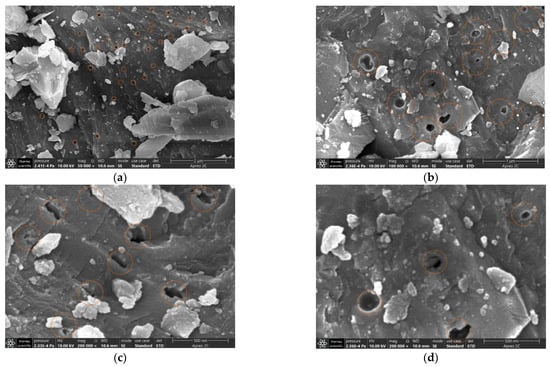
Figure 2.
Scanning electron microscopy of original volcanic. (a) 2 μm. (b) 1 μm. (c) 0.5 μm. (d) 0.5 μm.
The BET is based on the theory of multilayer adsorption, which is more similar to the actual absorption process of substances, so the measurement results are more accurate. The multilayer adsorption capacity of the samples under different nitrogen partial pressures was measured. The adsorption volume (V) was calculated as follows [47]:
where P0 is the saturation vapor pressure of N2 at 77.4 K, Pa; Vm is the N2 monolayer saturated adsorption capacity, mL; C is the constant related to sample adsorption capacity.
The results of N2 adsorption and desorption isotherms are shown in Figure 3. According to the classification of the International Union of Pure and Applied Chemistry (IUPAC), the three BET curves all present Type IV characteristics with an H4 hysteresis loop [48,49]. The hysteresis loop means that the adsorption line measured when the adsorption amount increases with the equilibrium pressure and the desorption line measured when the pressure decreases do not overlap within a certain relative pressure range, which is manifested as a ring. This indicates that capillary condensation occurs inside the pores. According to IUPAC, the resulting BET curves indicate that the material has a very pronounced amount of adsorption at the low end of P/P0, which is related to micropore and mesopore filling. This is also a typical curve for solids with narrow fractured pores. Automatic mercury intrusion porosimetry can measure the macropores, as shown in Figure 4. Finally, the pore volume, surface area and pore size of the original volcanic, composite-MgCl2 and composite-CaCl2 are listed in Table 4. The original volcanic, composite-MgCl2 and composite-CaCl2 have very few mesopores. Compared with the mesopore proportion of the composite material in [40], which is 27.11%, and the composite material in [7], which is 4.64%, the composite-MgCl2 and composite-CaCl2 mesopore proportion is less than 0.70%, as presented in Figure 5.
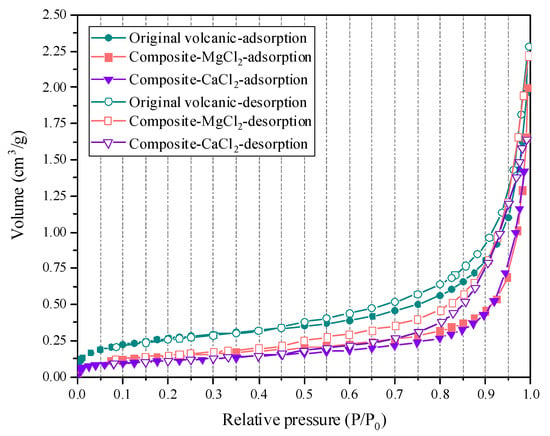
Figure 3.
N2 adsorption and desorption isotherms of original volcanic, composite-CaCl2 and composite-MgCl2.

Figure 4.
Pore distribution of original volcanic, composite-CaCl2 and composite-MgCl2.

Table 4.
Summary of surface area, pore volume and average pore size for the three materials.

Figure 5.
Proportion of macropore and mesopore in the three materials.
Moreover, the filling of MgCl2 and CaCl2 makes the surface area, pore volume and average pore size of the mesopores reduced. The addition of MgCl2 reduced the surface area of mesopores from 0.985 to 0.857 m2/g. If CaCl2 is added, the surface area is reduced to 0.800 m2/g. At the same time, the addition of MgCl2 and CaCl2 reduced the average pore size from 0.0144 µm to 00125 µm and 0.0119 µm, respectively, and the pore volume only decreased by 13.03% and 20.40%, respectively. The entry of hydrated salts into the mesopore is one of the reasons for the reduction in its surface area, pore volume and pore size [50]. In addition, it may also be due to the clogging of some mesopores by hydrated salts [48].
With the addition of hydrated salt, the mesopores decreased slightly, while the macropores decreased more significantly. The pore volume, pore area and pore size of macropores decreased after adding hydrated salt. The original volcanic has the largest surface area, pore volume and pore size, which are 7.348 m2/g, 0.525 cm3/g and 0.286 µm, respectively. The corresponding values of composite-MgCl2 are 4.843 m2/g, 0.323 cm3/g, and 0.223 µm. It is worth noting that the surface area and pore volume of composite-CaCl2 are greatly reduced by 56.67% and 46.10%, respectively. The macropores of the composite-CaCl2 show more decrease after soaking and adsorbing in the CaCl2 solution because the higher concentration of the CaCl2 solution makes more CaCl2 enter the interior of the original volcanic, which is beneficial to increase the energy storage capacity. In conclusion, the reduction of macropores is much greater than that of mesopores, which suggests that hydrated salts tend to fill larger pores.
The dried three materials were measured by X-ray diffraction, and the results are shown in Figure 6. The characteristic peaks of the original volcanic after testing are considered as a reference. The types of compounds are marked, and the original volcanic rocks have obvious characteristic peaks of silicates and ferric oxide. Compared with the original volcanic, composite-CaCl2 has two unique characteristic peaks belonging to CaCl2, located at 15.2° and 21.9° [32], and no other peaks appear. This indicates that CaCl2 has entered the inside of the volcanic, and no other chemical reactions have occurred. Similarly, the composite-MgCl2 test results indicate that only one MgCl2-related characteristic peak is added at the 31° position [2]. The positions of the characteristic peaks of silicates basically do not change; the characteristic peak of ferric oxide appears at around 53° [51] and remains unchanged. In summary, the XRD pattern is only related to volcanic and CaCl2 and MgCl2,which demonstrates that only physical binding and no chemical reaction has occurred. Because the original volcanic is mainly macropore, it does not have the ability to absorb water and release heat. The XRD pattern shows that the hydrated salts have entered the interior of the volcanic, and the water absorption capacity of the entire composites depend on the loading amount of the hydrated salts.
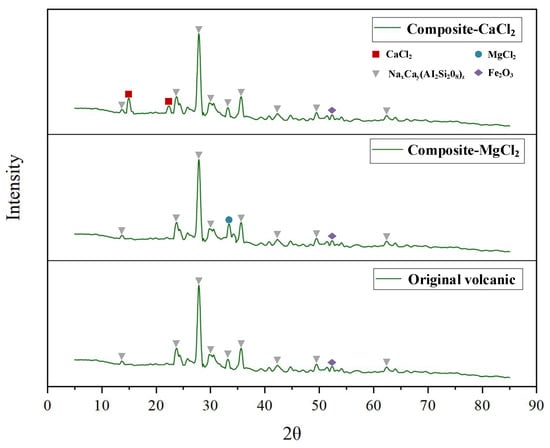
Figure 6.
XRD patterns of the three materials.
3.2. Adsorption Characteristics
The adsorption/desorption rate and capacity of water molecules are the key factors affecting thermochemical energy storage. From the comparison in Table 1, it can be seen that zeolite-MgCl2 has obvious economic advantages and high energy storage density. Moreover, zeolite, as a traditional material, has been studied by many scholars and has the potential for practical application. Therefore, zeolite-MgCl2 test results are added as a reference to evaluate the performance of the composites. The original volcanic, zeolite-MgCl2, composite-MgCl2 and composite-CaCl2 were completely dried for measurement. Figure 7 shows the water uptake test results of the original volcanic, zeolite-MgCl2, composite-MgCl2 and composite-CaCl2 at 30 °C and 60% humidity. The original volcanic takes the shortest time to reach saturation, and the final water uptake is less than 0.02 g/g. This is because of its pore structure with an average pore size of 286 nm, and water molecules (0.4 nm) in pores larger than 50 nm are hardly adsorbed and become crystal water. Therefore, the original volcanic cannot release heat after absorbing water and must rely on the contained hydrated salt. In the initial stage of adsorption, composite-CaCl2 shows the fastest water absorption rate. The reason is that CaCl2 has a stronger ability to combine the first two water molecules and become CaCl2·2H2O. The water uptake process of zeolite-MgCl2 is more stable than that of composite-CaCl2 or composite-MgCl2. In addition, the water uptake of zeolite-MgCl2 reaches saturation quickly, and the final water uptake is 0.22 g/g. Then composite-CaCl2 reaches saturated water uptake, and the water uptake is very slow in the later stage. The final water uptake of composite-CaCl2 is stable at 0.25 g/g. Composite-MgCl2 takes the longest time to reach saturated water uptake, and its water uptake rate drops significantly in the final stage, which is related to the instability of MgCl2·6H2O. However, composite-MgCl2 has the highest water uptake, which can reach 0.37 g/g.
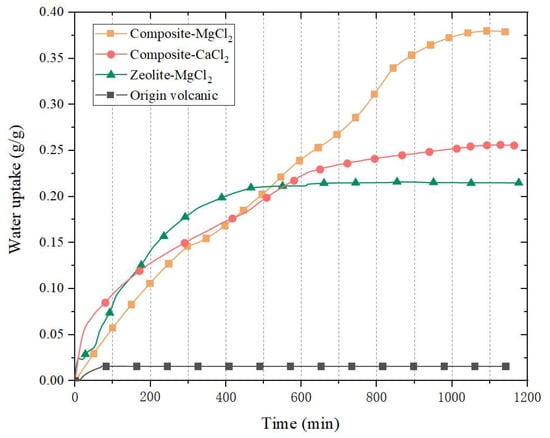
Figure 7.
Water adsorption kinetics curves of the materials at 30 °C and 60% humidity.
3.3. Thermal Properties Measurement
The changes in weight and heat flux of composite-CaCl2, composite-MgCl2 and zeolite-MgCl2 with temperature were probed by TG-DSC. Compared with zeolite-MgCl2, which is an excellent combination with high energy storage capacity and economic advantage, it is possible to evaluate the level achieved by the prepared composites. The composites were set to absorb water at 30 °C and 60% humidity until the weight no longer changed before the measurement. The measurement conditions were a heating rate of 5 °C/min and an N2 flow rate of 30 mL/min. Studies have shown that the removal of CaCl2·6H2O and MgCl2·6H2O water molecules is carried out step by step. It is worth noting that MgCl2·H2O is easily decomposed to produce HCl above 190 °C [2]. Therefore, the selected experimental temperature range for TG-DSC was 30–250 °C. The wide test temperature range is conducive to comprehensive observation and evaluation of the properties of the materials, which can determine the application temperature to avoid the formation of HCl.
Before testing, each sample absorbed water in a constant temperature and humidity chamber until the weight no longer changed. Then the samples were gradually heated by N2 gas flow, so the mass and heat flow changes of the composites could be recorded, as shown in Figure 8 and Figure 9. Among them, the mass change curves record the loss process of water molecules in the samples. Moreover, it is worth noting that the thermochemical energy storage density of each sample could be obtained by integrating each peak of the heat flow curves.
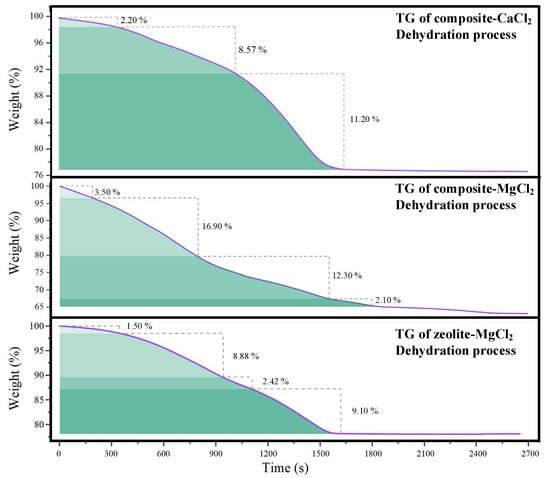
Figure 8.
Weight loss curves of composite-CaCl2, composite-MgCl2 and zeolite-MgCl2 by TG.
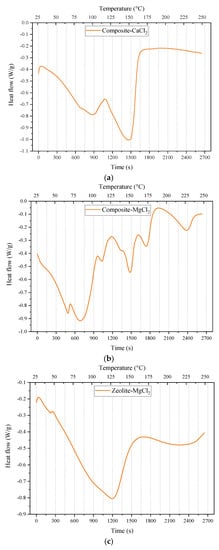
Figure 9.
Heat flow curves of composite-CaCl2, composite-MgCl2 and zeolite-MgCl2. (a) Composite-CaCl2; (b) composite-MgCl2; (c) zeolite-MgCl2.
As shown in Figure 8, the dehydration of composite-CaCl2 is mainly divided into three parts. The first step is the removal of water molecules in the solution contained in the materials; the second step is the loss of two water molecules in CaCl2·6H2O to become CaCl2·4H2O; and the third step is to lose most of the remaining water molecules to become CaCl2 2H2O and CaCl2 H2O [52]. Among them, the mass change of the third step is the largest, which is 11.20%. The decomposition of CaCl2·H2O needs to be above 200 °C, so it is not considered in this study. In addition, the dehydration process of composite-MgCl2 is divided into four steps: the first step is the removal of water in the solution, which is the same as composite-CaCl2; the second step is the removal of about two water molecules; the third step is to lose about two more water molecules; the fourth step is to lose one water molecule to become MgCl2·H2O. It is more appropriate that the final product is MgCl2·H2O; otherwise, HCl will be generated and the material will be lost. Meanwhile, the largest water loss occurs in the second step, which is mainly due to the instability of MgCl2·6H2O. The step-by-step dehydration process of zeolite-MgCl2 is not obvious, mainly because the zeolite itself dehydrates a large amount of water, which affects the observation of the dehydration of the hydrated salt.
The heat flow variation during the test is shown in Figure 9. The lower and upper axes are time and temperature, respectively, and the change of heat flow is displayed. The thermochemical energy storage density can be obtained by integrating the characteristic peaks of the heat flow curve. Figure 9a shows the dehydration process of composite-CaCl2, mainly including two absorption peaks. Among them, the first peak temperature is 96.4 °C, and the second peak temperature is 144.5 °C. Meanwhile, the dehydration process of composite-MgCl2 mainly appears in three peaks: the peaks are at 689 s, 1485 s and 1746 s, respectively, as shown in Figure 9b. It can be seen that there are peak fluctuations between the three main peaks. The peak of the first step of dehydration is located at 80 °C, and the peaks of the second and third steps are located at 116 °C and 153 °C, respectively. In addition, there is a heat flow change around 200 °C, which is due to the generation of HCl from the decomposition of MgCl2·H2O. This should be avoided in applications, as it would cause a loss of hydrated salts and reduce energy storage capacity, and this part of the peak is not calculated when calculating the thermochemical energy storage density. Figure 9c shows the heat flow curve of the dehydration process of zeolite-MgCl2, which is mainly one peak. This is caused by the small content of MgCl2·6H2O, and the removal of water molecules has little effect. The final fluctuations due to the decomposition of the material are not considered. In conclusion, the thermal chemical energy storage densities of zeolite-MgCl2, composite-CaCl2 and composite-MgCl2 are 630 kJ/kg, 641 kJ/kg, and 983 kJ/kg, respectively, after integrating the peak area of the heat flow curve. In addition, in order to prevent the decomposition of MgCl2·H2O to generate HCl and reduce the thermochemical energy storage capacity of the composites, it is recommended that the application temperature is below 160 °C.
3.4. Theoretical Evaluation of Thermochemical Energy Storage Density
The thermochemical energy storage density is theoretically calculated, and the results are compared with the measurement results to verify the accuracy. The thermochemical energy storage densities of composite-CaCl2 and composite-MgCl2 are mainly determined by the absorption heat of water molecules in the dehydration process. Therefore, the thermochemical energy storage density (Ed, kJ/kg) per kilogram of material can be obtained by accumulating the absorption heat of each step as in Equation (2).
where is water uptake per gram of material, g/g; is the dehydration heat per mole water, kJ/mol; is the relative molecular mass of H2O. The dehydration heat of water molecules of CaCl2-hydrate is obtained from reference [53], while the dehydration heat of water molecules of MgCl2-hydrate is referred to in [40]. The change of water uptake in each step of dehydration has been analyzed in Section 3.3.
Figure 10 shows the composition of thermochemical energy storage densities of composite-CaCl2, composite-MgCl2 and zeolite-MgCl2. From the weight loss curve of the dehydration process, it can be seen that there is a certain solution in the initial dehydration period. The heat required for water removal in CaCl2 solution is about 25.14 kJ/kg, accounting for about 3.75%. At the same time, the removal of water molecules in the first step contributes the most to the thermochemical energy storage density, accounting for 54.32%. This is because the dehydration heat of CaCl2·6H2O~CaCl2·4H2O is higher [54]. Finally, the thermochemical energy storage density of composite-CaCl2 is theoretically calculated to be 670.14 kJ/kg. This is only 4.55% different from the previous conclusion obtained by DSC measurement. However, there is no difference between the dehydration heat of the first step and the second step in the dehydration process of composite-MgCl2, so their contributions to the thermochemical energy storage density are similar [40]; 473.37 kJ/kg can be achieved in the first step, accounting for 48.79% of total thermochemical energy storage density. In addition, the absorption heat of the fourth dehydration process (MgCl2·2H2O~MgCl2·H2O) is only 64.75 kJ/kg. This is because the amount of water molecules removed is small and the dehydration heat per mole is low. In short, its thermochemical energy storage density is theoretically calculated to be 970.29 kJ/kg, which is only 1.29% different from the DSC measurement result. Moreover, the thermochemical energy storage characteristic of zeolites has been studied by many scholars. However, only 13.19% of the increase in the thermochemical energy storage density of zeolite-MgCl2 comes from the addition of hydrated salt. The difference between the theoretical calculation value and the measured value of thermochemical energy storage density is only 5.26%. It is noteworthy that, in terms of thermochemical energy storage density, the prepared composite-CaCl2 can reach the level of zeolite-MgCl2.
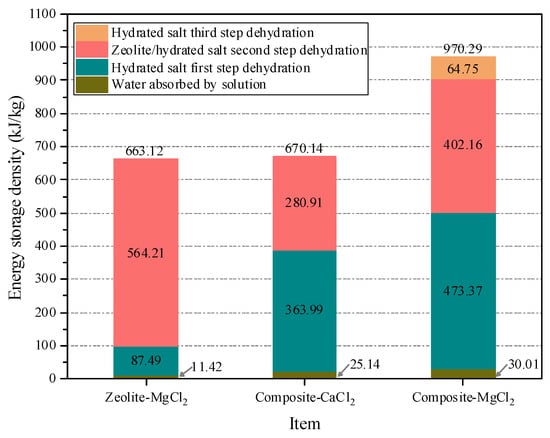
Figure 10.
Composition of the thermochemical energy storage densities of the three composites.
3.5. Cycle Stability
Under the same conditions as in the previous preparation process, the prepared composites were tested for 10 adsorption/desorption cycles. The water absorption test was at 30 °C and 60% humidity, while drying and TG-DSC were in the 20–250 °C temperature range. In addition, considering the degradation of volcanic [55,56], a natural material, a cycle stability test of it was also added. The samples after each cycle were weighed and compared with the initial samples, and the results are shown in Figure 11. The weight of both composites dropped significantly during the first several cycles. From the sixth cycle, the weight drop of composite-MgCl2 tends to be flat, and the weight change decreases. Similarly, the weight of volcanic hardly changed after the fifth cycle. But the weight change of composite-CaCl2 does not significantly decrease until the eighth cycle. Finally, after 10 cycles, the weight of the volcanic is stable at 94.01% of the initial weight, and the weight of composite-MgCl2 and composite-CaCl2 decreased by 12.08% and 14.08%, respectively.
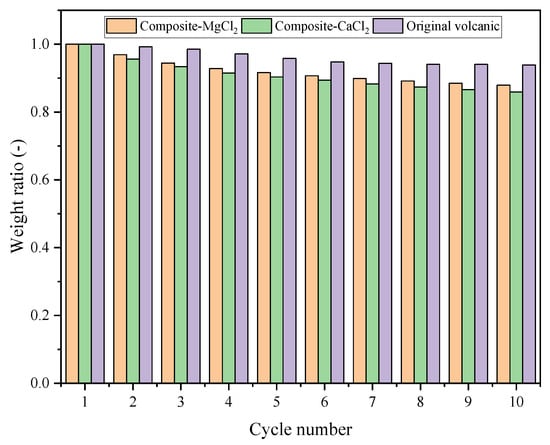
Figure 11.
Sample weight change after several adsorption/desorption cycles.
The energy storage capacity of composites is largely influenced by the water vapor adsorption rate and ability. Among them, higher vapor pressure will promote hydration reaction and achieve faster water adsorption and faster energy storage rate [23], which is suitable for applications when solar energy is insufficient and needs to be collected quickly. Excessive humidity may also cause the composites to overhydrate and leak, which should be avoided. The effect of adsorption kinetics on thermochemical energy storage density is complex and not completely linear, thus requiring simplifications when performing cycling tests. The temperature required for domestic heating is not lower than 30 °C, so 30 °C and a humidity of 60% are selected for the cycle stability test conditions. The volcanic can hardly absorb water vapor, and the increased moisture can be attributed to the hydrated salts in the composites. When the adsorbent reaches adsorption equilibrium and the mass of the adsorbent does not increase with time, the maximum adsorption ability (Weq) is
where Wf is the final mass of the sorbent, g; W0 is the initial mass of the sorbent, g.
The water absorption/dehydration ability of the composites is a key factor affecting the thermochemical energy storage performance. As shown in Figure 12, the final water uptake of composite-MgCl2 dropped rapidly in the first few cycles and hardly changed after the sixth cycle. The final water uptake of composite-CaCl2 gradually decreased and became stable within 10 cycles. Similarly, the reduction in both composites was dramatic during the first six cycles and then plateaued. The water absorption of composite-MgCl2 and composite-CaCl2 was stable at about 0.29 g/g and 0.17 g/g, respectively. In order to determine the effect of multiple cycles on the energy storage density of the composites, the samples were taken to DSC tests after fully absorbing water at 30 °C and 60% humidity. Ten cycles were carried out to detect changes in energy storage density, as shown in Figure 13. The energy storage density of the composite-MgCl2 decays to 823 kJ/kg after the fourth cycle, and finally stabilizes at 773 kJ/kg. The reduction in the energy storage density of the composite-CaCl2 weakened after the third cycle, and it finally retained a storage energy density of 456 kJ/kg.
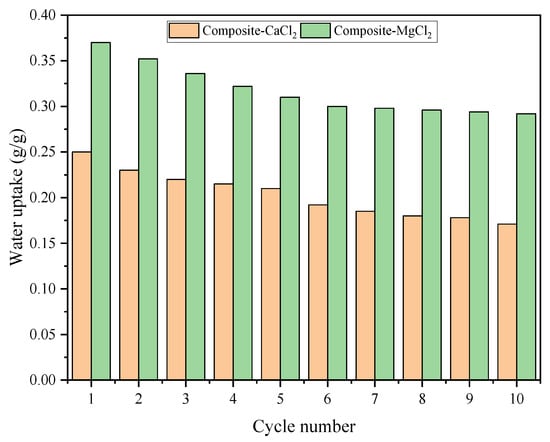
Figure 12.
Changes in water uptake after multiple cycles at 30 °C and 60% humidity.
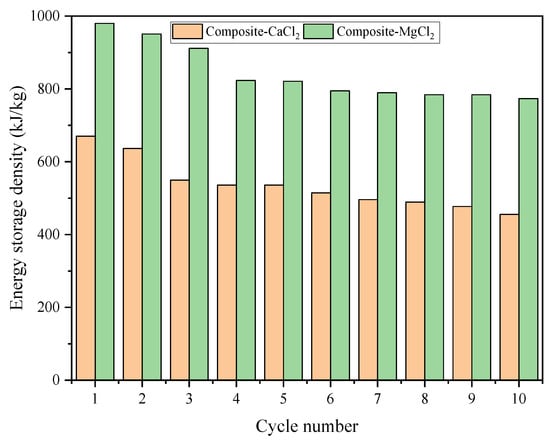
Figure 13.
Changes in energy storage density after multiple cycles.
4. Further Discussion
The preparation process and cost of thermochemical energy storage materials are the key factors affecting their application. The proposed composites are compared with the materials in Table 1 for evaluation.
In terms of the choice of porous substrate, as a mature thermochemical energy storage material, zeolites need to be combined with hydrated salts to further enhance their energy storage capacity. However, the ability of zeolite itself to support hydrated salts is very low. Zeolite does not exist naturally and needs to be prepared through multi-step chemical processes, which results in a higher price than natural materials. Some excellent zeolites can support higher concentrations of hydrated salts (~15 wt%), but the preparation of such zeolites requires more chemical processes. Nevertheless, the zeolite/MgCl2 composite is a combination with mature technology and stable performance that has practical applications. In addition, in order to further explore the substance with better performance, many advanced materials have been studied, but they are facing the problem of high cost. Advanced materials (expanded graphite, MIL-101(Cr), etc.) can load higher ratios of hydrated salts (60~80 wt%) and have high energy storage density, but they are too expensive. In the future, after their prices are reduced, they are potential substrates. Compared with the literature, the volcanic selected in this study does not need to undergo multi-step pretreatment, which reduces the cost. Moreover, it is very cheap with extremely low mining costs in Yunnan, China, and has the potential for practical application.
It is worth noting that the selection of hydrated salts is very important. The price of hydrated salts is also a key factor affecting the overall price of composite materials. Vermiculite is a relatively cheap material, but the type of hydrated salts it loads will seriously affect the thermal performance and economy of the composite. When vermiculite is loaded with more expensive hydrated salts, such as LiCl, it has a high thermochemical energy storage density, but this leads to high costs [35]. If vermiculite is combined with a hydrated salt with low price and moderate performance, such as CaCl2, the prepared composite has obvious economic advantages and moderate thermochemical heat storage capacity [29]. In the selection of hydrated salts, CaCl2 and MgCl2 are hydrated salts with stable performance and mature application technology. Their low price will not limit their large-scale application.
According to the thermal performance measurement and analysis, the performance of the composites in this study is at a relatively high level. Figure 14 shows the improved performance of the prepared composites compared to the technologically mature and potentially applied zeolite-MgCl2. The level of the prepared composites can be evaluated by comparison with zeolite-MgCl2, which has a very low energy storage density cost. Among them, compared with the zeolite-MgCl2, the thermochemical energy storage density of the prepared composite-CaCl2 is already close to it, which is 1.02 times higher. The thermochemical energy storage density of composite-MgCl2 is 1.53 times that of composite -CaCl2. At the same time, the thermochemical energy storage density of composite-MgCl2 is 1.56 times that of zeolite-MgCl2. The proposed two composites have advantages in terms of thermochemical energy storage. Even after many cycles, the energy storage density of composite-MgCl2 is at a high level.
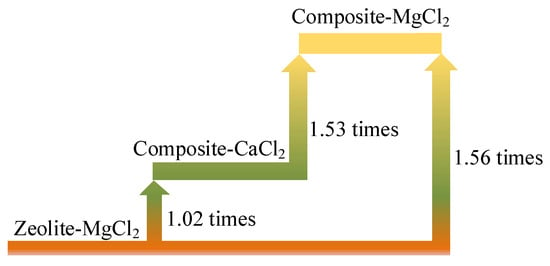
Figure 14.
Comparison of thermochemical energy storage density increase ratio of three composites.
Table 5 shows prices for various chemical reagents. Since the preparation process of zeolite itself is complicated, the raw materials need to be pickled, alkali washed, sintered, etc., and its price is relatively high. In contrast, the price of volcanic is 0.3 yuan/kg, only 0.86% of zeolite, which greatly reduces the cost. In addition, CaCl2 and MgCl2 are commonly sold by various enterprises in China. Finally, the prices of the prepared composite-CaCl2 and composite-MgCl2 are only 7.17 yuan/kg and 16.86 yuan/kg, only 16.39% and 38.54% of zeolite-MgCl2. Finally, the energy storage density cost of composite-MgCl2 is 0.0174 yuan/kJ, and that of composite-CaCl2 is as low as 0.0107 yuan/kJ, which is less than half of that of zeolite- MgCl2. Even after many cycles, the energy storage density cost of composite-MgCl2 and composite-CaCl2 is still as low as 0.0218 yuan/kJ and 0.0157 yuan/kJ, respectively, after the energy storage capacity decreases.

Table 5.
Summary of economic analysis of three composites.
Comparing the energy storage density cost of composite-MgCl2 and composite-CaCl2 with the composites in Table 1, it can be seen that the zeolite-MgCl2 prepared in the literature [2] has a lower energy storage density cost, but the energy storage density cost of the composite-MgCl2 after multiple cycles is 76.32% of it, while that of the composite-CaCl2 after multiple cycles is 54.90% of it. Compared with the studies using advanced macroporous materials in Table 1, the proposed composites show obvious economical advantages. This indicates that the prepared thermochemical energy storage materials have better application potential in terms of economy.
Finally, in terms of energy storage capacity, economic costs need to be considered at the same time. Among them, composite-MgCl2 has a higher energy storage density and is more suitable for energy storage scenarios with limited space, while composite-CaCl2 has a lower energy storage density cost and is suitable for energy storage scenarios with sufficient space and cost considerations. In terms of cyclicity, composite-MgCl2 more easily achieves stability than composite-CaCl2. Therefore, composite-MgCl2 is suitable for frequent storage and release, while composite-CaCl2 is suitable for energy storage scenarios with long storage time and low storage/release frequency.
5. Conclusions
Novel hydrated salt composite materials for thermochemical energy storage were developed and evaluated. As the main skeleton of hydrated salt, the volcanic adsorbs CaCl2 and MgCl2 through its macropores, and composite-CaCl2 and composite-MgCl2 were prepared. A lot of characterization tests were performed on composite materials to measure their properties, water absorption and energy storage capabilities. They are compared with zeolite-MgCl2 and other materials in terms of thermal performance and economy to evaluate their potential in medium- and low-temperature (<160 °C) energy storage. This study provides guidance for the application of thermochemical energy storage technology in building heating.
- In the composite-CaCl2 and composite-MgCl2, the hydrated salts tend to fill the macropores in the volcanic.
- The water uptake of composite-CaCl2 and composite-MgCl2 e can reach 0.25 g/g and 0.37 g/g, respectively.
- According to TG-DSC measurement, the thermochemical energy storage densities of zeolite-MgCl2, composite-CaCl2 and composite-MgCl2 are 630 kJ/kg, 641 kJ/kg and 983 kJ/kg, respectively. This indicates that the prepared composite-CaCl2 has reached the level of zeolite-MgCl2.
- According to theoretical calculations, the thermochemical energy storage densities of the proposed composites are mainly determined by the hydrated salts. The theoretically calculated energy storage densities of the three materials are not much different from the measured results.
- Compared with other materials, the selected substrate and hydrated salts of the prepared composites have good economy and relatively high thermochemical energy storage performance. Even after many cycles, the energy storage capacity is still high.
- The thermochemical energy storage density of composite-MgCl2 is 1.56 times that of zeolite-MgCl2. The energy storage density of composite-CaCl2 is close to that of zeolite-MgCl2, but the energy storage density cost is only 0.0107 yuan/kJ. Even after many cycles, the energy storage density cost of composite-MgCl2 and composite-CaCl2 is still as low as 0.0218 yuan/kJ and 0.0157 yuan/kJ, respectively.
In the follow-up work, on the one hand, the research on the adsorption kinetics of the composites should be emphasized, and it is very important to clarify the adsorption characteristics of the composites for practical applications. More water absorption does not mean higher thermochemical energy storage density, so it is very important to explore the interaction mechanism between operating conditions and energy storage performance. Moreover, the thermal conductivity of the prepared composite is low, which should be optimized.
Author Contributions
Investigation, Z.Z., Z.W. and Y.S.; Methodology, Y.W.; Validation, S.L.; Writing—original draft, Y.W. All authors have read and agreed to the published version of the manuscript.
Funding
This research was funded by the National Natural Science Foundation of China (No. 52178063) and Ministry of Science and Technology of the People’s Republic of China (No. G2022178022L).
Data Availability Statement
No data set was created.
Conflicts of Interest
The authors declare no conflict of interest.
Nomenclature
| Symbols | |
| C | Cost, yuan/kg |
| E | Energy density, kJ/kg |
| h | Dehydration heat, kJ/mol |
| m | Water uptake, g/g |
| M | Relative molecular mass, g/mol |
| P | Pressure, MPa |
| T | Temperature, °C |
| Subscripts | |
| 0 | Saturation |
| d | Density |
| m | Material |
| s | Standard |
| Abbreviations | |
| BET | Brunauer-Emmett-Teller |
| DSC | Differential scanning calorimetry |
| EG | Expanded graphite |
| IEA | International Energy Agency |
| SEM | Scanning electron microscopy |
| TCES | Thermochemical energy storage |
| TES | Thermal energy storage |
| TG | Thermo-gravimetric |
References
- Clark, R.-J.; Mehrabadi, A.; Farid, M. State of the art on salt hydrate thermochemical energy storage systems for use in building applications. J. Energy Storage 2020, 27, 101145. [Google Scholar] [CrossRef]
- Whiting, G.T.; Grondin, D.; Stosic, D.; Bennici, S.; Auroux, A. Zeolite–MgCl2 composites as potential long-term heat storage materials: Influence of zeolite properties on heats of water sorption. Sol. Energy Mater. Sol. Cells 2014, 128, 289–295. [Google Scholar] [CrossRef]
- Mehrabadi, A.; Farid, M. New salt hydrate composite for low-grade thermal energy storage. Energy 2018, 164, 194–203. [Google Scholar] [CrossRef]
- Zhang, Y.; Wang, R. Sorption thermal energy storage: Concept, process, applications and perspectives. Energy Storage Mater. 2020, 27, 352–369. [Google Scholar] [CrossRef]
- André, L.; Abanades, S. Recent advances in thermochemical energy storage via solid–gas reversible reactions at high temperature. Energies 2020, 13, 5859. [Google Scholar] [CrossRef]
- Yang, H.; Wang, C.; Tong, L.; Yin, S.; Wang, L.; Ding, Y. Salt Hydrate Adsorption Material-Based Thermochemical Energy Storage for Space Heating Application: A Review. Energies 2023, 16, 2875. [Google Scholar] [CrossRef]
- Li, W.; Klemeš, J.J.; Wang, Q.; Zeng, M. Development and characteristics analysis of salt-hydrate based composite sorbent for low-grade thermochemical energy storage. Renew. Energy 2020, 157, 920–940. [Google Scholar] [CrossRef]
- Ji, W.; Zhang, H.; Liu, S.; Wang, Z.; Deng, S. An experimental study on the binary hydrated salt composite zeolite for improving thermochemical energy storage performance. Renew. Energy 2022, 194, 1163–1173. [Google Scholar] [CrossRef]
- Lefebvre, D.; Tezel, F.H. A review of energy storage technologies with a focus on adsorption thermal energy storage processes for heating applications. Renew. Sustain. Energy Rev. 2017, 67, 116–125. [Google Scholar] [CrossRef]
- Scapino, L.; Zondag, H.A.; Van Bael, J.; Diriken, J.; Rindt, C.C.M. Sorption heat storage for long-term low-temperature applications: A review on the advancements at material and prototype scale. Appl. Energy 2017, 190, 920–948. [Google Scholar] [CrossRef]
- Lim, K.; Che, J.; Lee, J. Experimental study on adsorption characteristics of a water and silica-gel based thermal energy storage (TES) system. Appl. Therm. Eng. 2017, 110, 80–88. [Google Scholar] [CrossRef]
- Strong, C.; Carrier, Y.; Tezel, F.H. Experimental optimization of operating conditions for an open bulk-scale silica gel/water vapour adsorption energy storage system. Appl. Energy 2022, 312, 118533. [Google Scholar] [CrossRef]
- Johannes, K.; Kuznik, F.; Hubert, J.-L.; Durier, F.; Obrecht, C. Design and characterisation of a high powered energy dense zeolite thermal energy storage system for buildings. Appl. Energy 2015, 159, 80–86. [Google Scholar] [CrossRef]
- Xu, S.; Lemington; Wang, R.; Wang, L.; Zhu, J. A zeolite 13X/magnesium sulfate–water sorption thermal energy storage device for domestic heating. Energy Convers. Manag. 2018, 171, 98–109. [Google Scholar] [CrossRef]
- Shkatulov, A.; Houben, J.; Fischer, H.; Huinink, H. Stabilization of K2CO3 in vermiculite for thermochemical energy storage. Renew. Energy 2020, 150, 990–1000. [Google Scholar] [CrossRef]
- Zhang, Y.; Wang, R.; Li, T.; Zhao, Y. Thermochemical characterizations of novel vermiculite-LiCl composite sorbents for low-temperature heat storage. Energies 2016, 9, 854. [Google Scholar] [CrossRef]
- Miao, Q.; Zhang, Y.; Jia, X.; Li, Z.; Tan, L.; Ding, Y. MgSO4-expanded graphite composites for mass and heat transfer enhancement of thermochemical energy storage. Sol. Energy 2021, 220, 432–439. [Google Scholar] [CrossRef]
- Lin, J.; Zhao, Q.; Huang, H.; Mao, H.; Liu, Y.; Xiao, Y. Applications of low-temperature thermochemical energy storage systems for salt hydrates based on material classification: A review. Sol. Energy 2021, 214, 149–178. [Google Scholar] [CrossRef]
- Zhao, Q.; Lin, J.; Huang, H.; Wu, Q.; Shen, Y.; Xiao, Y. Optimization of thermochemical energy storage systems based on hydrated salts: A review. Energy Build. 2021, 244, 111035. [Google Scholar] [CrossRef]
- Kumar, E.A.; Jivrakh, K.B.; Babu, K.S. Study of ammonia adsorption/desorption characteristics of CaCl2–Expanded natural graphite composite for thermal energy storage. Therm. Sci. Eng. Prog. 2020, 20, 100752. [Google Scholar] [CrossRef]
- Shere, L.; Trivedi, S.; Roberts, S.; Sciacovelli, A.; Ding, Y. Synthesis and characterization of thermochemical storage material combining porous zeolite and inorganic salts. Heat Transf. Eng. 2018, 40, 1176–1181. [Google Scholar] [CrossRef]
- Jiang, L.; Lin, Y.; Liu, W.; Ma, Z.; Wang, R.; Zhang, X.; Roskilly, A. Thermophysical characterization of magnesium chloride and its application in open sorption thermal energy storage system. Sol. Energy Mater. Sol. Cells 2022, 236, 111528. [Google Scholar] [CrossRef]
- Li, W.; Klemeš, J.J.; Wang, Q.; Zeng, M. Characterisation and sorption behaviour of LiOH-LiCl@ EG composite sorbents for thermochemical energy storage with controllable thermal upgradeability. Chem. Eng. J. 2021, 421, 129586. [Google Scholar] [CrossRef]
- Grekova, A.D.; Gordeeva, L.G.; Aristov, Y.I. Composite “LiCl/vermiculite” as advanced water sorbent for thermal energy storage. Appl. Therm. Eng. 2017, 124, 1401–1408. [Google Scholar] [CrossRef]
- Clark, R.-J.; Farid, M. Experimental investigation into the performance of novel SrCl2-based composite material for thermochemical energy storage. J. Energy Storage 2021, 36, 102390. [Google Scholar] [CrossRef]
- Clark, R.-J.; Gholamibozanjani, G.; Woods, J.; Kaur, S.; Odukomaiya, A.; Al-Hallaj, S.; Farid, M. Experimental screening of salt hydrates for thermochemical energy storage for building heating application. J. Energy Storage 2022, 51, 104415. [Google Scholar] [CrossRef]
- Mastronardo, E.; La Mazza, E.; Palamara, D.; Piperopoulos, E.; Iannazzo, D.; Proverbio, E.; Milone, C. Organic salt hydrate as a novel paradigm for thermal energy storage. Energies 2022, 15, 4339. [Google Scholar] [CrossRef]
- Chao, J.; Xu, J.; Bai, Z.; Wang, P.; Wang, R.; Li, T. Integrated heat and cold storage enabled by high-energy-density sorption thermal battery based on zeolite/MgCl2 composite sorbent. J. Energy Storage 2023, 64, 107155. [Google Scholar] [CrossRef]
- Jabbari-Hichri, A.; Bennici, S.; Auroux, A. CaCl2-containing composites as thermochemical heat storage materials. Sol. Energy Mater. Sol. Cells 2017, 172, 177–185. [Google Scholar] [CrossRef]
- Xu, S.; Wang, R.; Wang, L.; Zhu, J. Performance characterizations and thermodynamic analysis of magnesium sulfate-impregnated zeolite 13X and activated alumina composite sorbents for thermal energy storage. Energy 2019, 167, 889–901. [Google Scholar] [CrossRef]
- Gaeini, M.; Rouws, A.; Salari, J.; Zondag, H.; Rindt, C. Characterization of microencapsulated and impregnated porous host materials based on calcium chloride for thermochemical energy storage. Appl. Energy 2018, 212, 1165–1177. [Google Scholar] [CrossRef]
- Wei, S.; Zhou, W.; Han, R.; Li, J.; Gao, J.; Zhao, G.; Qin, Y. Scalable Production of EP/CaCl2@ C Multistage Core–Shell Sorbent for Solar-Driven Sorption Heat Storage Application. Energy Fuels 2021, 35, 6845–6857. [Google Scholar] [CrossRef]
- Posern, K.; Kaps, C. Calorimetric studies of thermochemical heat storage materials based on mixtures of MgSO4 and MgCl2. Thermochim. Acta 2010, 502, 73–76. [Google Scholar] [CrossRef]
- Ousaleh, H.A.; Sair, S.; Mansouri, S.; Abboud, Y.; Faik, A.; El Bouari, A. New hybrid graphene/inorganic salt composites for thermochemical energy storage: Synthesis, cyclability investigation and heat exchanger metal corrosion protection performance. Sol. Energy Mater. Sol. Cells 2020, 215, 110601. [Google Scholar] [CrossRef]
- Brancato, V.; Gordeeva, L.G.; Sapienza, A.; Palomba, V.; Vasta, S.; Grekova, A.D.; Frazzica, A.; Aristov, Y.I. Experimental characterization of the LiCl/vermiculite composite for sorption heat storage applications. Int. J. Refrig. 2019, 105, 92–100. [Google Scholar] [CrossRef]
- Liu, H.; Nagano, K.; Togawa, J. A composite material made of mesoporous siliceous shale impregnated with lithium chloride for an open sorption thermal energy storage system. Sol. Energy 2015, 111, 186–200. [Google Scholar] [CrossRef]
- Cammarata, A.; Verda, V.; Sciacovelli, A.; Ding, Y. Hybrid strontium bromide-natural graphite composites for low to medium temperature thermochemical energy storage: Formulation, fabrication and performance investigation. Energy Convers. Manag. 2018, 166, 233–240. [Google Scholar] [CrossRef]
- Calabrese, L.; Brancato, V.; Palomba, V.; Frazzica, A.; Cabeza, L.F. Magnesium sulphate-silicone foam composites for thermochemical energy storage: Assessment of dehydration behaviour and mechanical stability. Sol. Energy Mater. Sol. Cells 2019, 200, 109992. [Google Scholar] [CrossRef]
- d’Ans, P.; Courbon, E.; Permyakova, A.; Nouar, F.; Simonnet-Jegat, C.; Bourdreux, F.; Malet, L.; Serre, C.; Frere, M.; Steunou, N. A new strontium bromide MOF composite with improved performance for solar energy storage application. J. Energy Storage 2019, 25, 100881. [Google Scholar] [CrossRef]
- Xu, J.; Li, T.; Chao, J.; Yan, T.; Wang, R. High energy-density multi-form thermochemical energy storage based on multi-step sorption processes. Energy 2019, 185, 1131–1142. [Google Scholar] [CrossRef]
- Rammelberg, H.U.; Osterland, T.; Priehs, B.; Opel, O.; Ruck, W.K. Thermochemical heat storage materials–Performance of mixed salt hydrates. Sol. Energy 2016, 136, 571–589. [Google Scholar] [CrossRef]
- Sögütoglu, L.; Donkers, P.; Fischer, H.; Huinink, H.; Adan, O. In-depth investigation of thermochemical performance in a heat battery: Cyclic analysis of K2CO3, MgCl2 and Na2S. Appl. Energy 2018, 215, 159–173. [Google Scholar] [CrossRef]
- Ferchaud, C.J.; Zondag, H.A.; Veldhuis, J.B.J.; De Boer, R. Study of the reversible water vapour sorption process of MgSO4. 7H2O and MgCl2. 6H2O under the conditions of seasonal solar heat storage. J. Phys. Conf. Ser. 2012, 395, 012069. [Google Scholar] [CrossRef]
- Molenda, M.; Stengler, J.; Linder, M.; Wörner, A. Reversible hydration behavior of CaCl2 at high H2O partial pressures for thermochemical energy storage. Thermochim. Acta 2013, 560, 76–81. [Google Scholar] [CrossRef]
- Zhou, H.; Zhang, D. Effect of graphene oxide aerogel on dehydration temperature of graphene oxide aerogel stabilized MgCl2·6H2O composites. Sol. Energy 2019, 184, 202–208. [Google Scholar] [CrossRef]
- Wei, S.; Zhou, W.; Han, R.; Gao, J.; Zhao, G.; Qin, Y.; Wang, C. Influence of minerals with different porous structures on thermochemical heat storage performance of CaCl2-based composite sorbents. Sol. Energy Mater. Sol. Cells 2022, 243, 111769. [Google Scholar] [CrossRef]
- Gibson, N.; Kuchenbecker, P.; Rasmussen, K.; Hodoroaba, V.-D.; Rauscher, H. Volume-specific surface area by gas adsorption analysis with the BET method. In Characterization of Nanoparticles; Elsevier: Amsterdam, The Netherlands, 2020; pp. 265–294. [Google Scholar]
- Singh, S.B.; De, M. Alumina based doped templated carbons: A comparative study with zeolite and silica gel templates. Microporous Mesoporous Mater. 2018, 257, 241–252. [Google Scholar] [CrossRef]
- Zhang, D.; Wen, X.; Shi, L.; Yan, T.; Zhang, J. Enhanced capacitive deionization of graphene/mesoporous carbon composites. Nanoscale 2012, 4, 5440–5446. [Google Scholar] [CrossRef] [PubMed]
- Kishor, R.; Singh, S.B.; Ghoshal, A.K. Role of metal type on mesoporous KIT-6 for hydrogen storage. Int. J. Hydrogen Energy 2018, 43, 10376–10385. [Google Scholar] [CrossRef]
- Kazemifard, S.; Nayebzadeh, H.; Saghatoleslami, N.; Safakish, E. Application of magnetic alumina-ferric oxide nanocatalyst supported by KOH for in-situ transesterification of microalgae cultivated in wastewater medium. Biomass Bioenergy 2019, 129, 105338. [Google Scholar] [CrossRef]
- Iyimen-Schwarz, Z.; Lechner, M.D. Energiespeicherung durch chemische Reaktionen. I. DSC-Messungen zur quantitativen Verfolgung der Enthalpieänderungen von Speicherstoffen für die Hin-und Rückreaktion. Thermochim. Acta 1983, 68, 349–361. [Google Scholar] [CrossRef]
- N’Tsoukpoe, K.E.; Rammelberg, H.U.; Lele, A.F.; Korhammer, K.; Watts, B.A.; Schmidt, T.; Ruck, W.K. A review on the use of calcium chloride in applied thermal engineering. Appl. Therm. Eng. 2015, 75, 513–531. [Google Scholar] [CrossRef]
- van Alebeek, R.; Scapino, L.; Beving, M.; Gaeini, M.; Rindt, C.; Zondag, H. Investigation of a household-scale open sorption energy storage system based on the zeolite 13X/water reacting pair. Appl. Therm. Eng. 2018, 139, 325–333. [Google Scholar] [CrossRef]
- Alraddadi, S.; Assaedi, H. Physical properties of mesoporous scoria and pumice volcanic rocks. J. Phys. Commun. 2021, 5, 115018. [Google Scholar] [CrossRef]
- Mourhly, A.; Khachani, M.; El Hamidi, A.; Kacimi, M.; Halim, M.; Arsalane, S. The synthesis and characterization of low-cost mesoporous silica SiO2 from local pumice rock. Nanomater. Nanotechnol. 2015, 5, 35. [Google Scholar] [CrossRef]
Disclaimer/Publisher’s Note: The statements, opinions and data contained in all publications are solely those of the individual author(s) and contributor(s) and not of MDPI and/or the editor(s). MDPI and/or the editor(s) disclaim responsibility for any injury to people or property resulting from any ideas, methods, instructions or products referred to in the content. |
© 2023 by the authors. Licensee MDPI, Basel, Switzerland. This article is an open access article distributed under the terms and conditions of the Creative Commons Attribution (CC BY) license (https://creativecommons.org/licenses/by/4.0/).